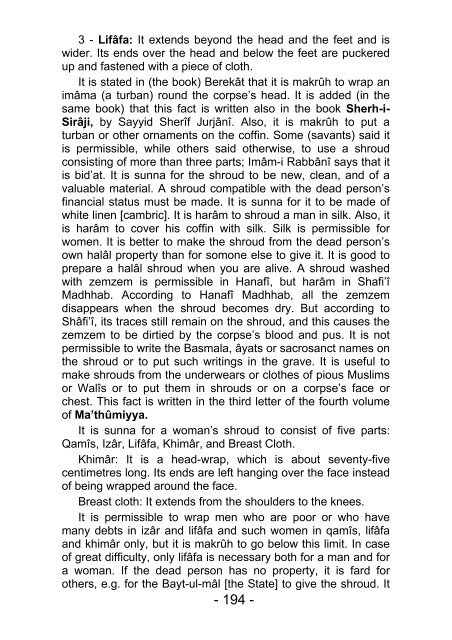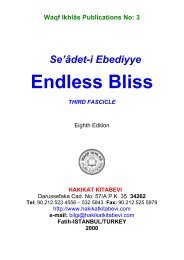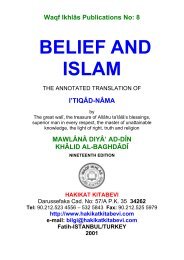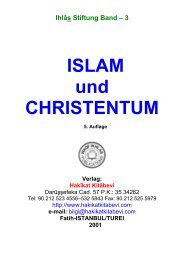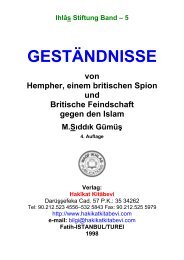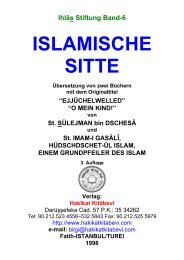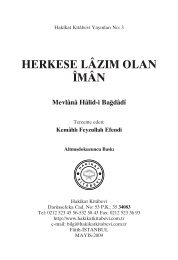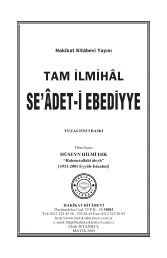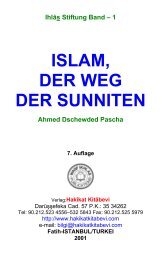5-Endless Bliss Fifth Fascicle - Hakikat Kitabevi
5-Endless Bliss Fifth Fascicle - Hakikat Kitabevi
5-Endless Bliss Fifth Fascicle - Hakikat Kitabevi
You also want an ePaper? Increase the reach of your titles
YUMPU automatically turns print PDFs into web optimized ePapers that Google loves.
3 - Lifâfa: It extends beyond the head and the feet and is<br />
wider. Its ends over the head and below the feet are puckered<br />
up and fastened with a piece of cloth.<br />
It is stated in (the book) Berekât that it is makrûh to wrap an<br />
imâma (a turban) round the corpse’s head. It is added (in the<br />
same book) that this fact is written also in the book Sherh-i-<br />
Sirâji, by Sayyid Sherîf Jurjânî. Also, it is makrûh to put a<br />
turban or other ornaments on the coffin. Some (savants) said it<br />
is permissible, while others said otherwise, to use a shroud<br />
consisting of more than three parts; Imâm-i Rabbânî says that it<br />
is bid’at. It is sunna for the shroud to be new, clean, and of a<br />
valuable material. A shroud compatible with the dead person’s<br />
financial status must be made. It is sunna for it to be made of<br />
white linen [cambric]. It is harâm to shroud a man in silk. Also, it<br />
is harâm to cover his coffin with silk. Silk is permissible for<br />
women. It is better to make the shroud from the dead person’s<br />
own halâl property than for somone else to give it. It is good to<br />
prepare a halâl shroud when you are alive. A shroud washed<br />
with zemzem is permissible in Hanafî, but harâm in Shafi’î<br />
Madhhab. According to Hanafî Madhhab, all the zemzem<br />
disappears when the shroud becomes dry. But according to<br />
Shâfi’î, its traces still remain on the shroud, and this causes the<br />
zemzem to be dirtied by the corpse’s blood and pus. It is not<br />
permissible to write the Basmala, âyats or sacrosanct names on<br />
the shroud or to put such writings in the grave. It is useful to<br />
make shrouds from the underwears or clothes of pious Muslims<br />
or Walîs or to put them in shrouds or on a corpse’s face or<br />
chest. This fact is written in the third letter of the fourth volume<br />
of Ma’thûmiyya.<br />
It is sunna for a woman’s shroud to consist of five parts:<br />
Qamîs, Izâr, Lifâfa, Khimâr, and Breast Cloth.<br />
Khimâr: It is a head-wrap, which is about seventy-five<br />
centimetres long. Its ends are left hanging over the face instead<br />
of being wrapped around the face.<br />
Breast cloth: It extends from the shoulders to the knees.<br />
It is permissible to wrap men who are poor or who have<br />
many debts in izâr and lifâfa and such women in qamîs, lifâfa<br />
and khimâr only, but it is makrûh to go below this limit. In case<br />
of great difficulty, only lifâfa is necessary both for a man and for<br />
a woman. If the dead person has no property, it is fard for<br />
others, e.g. for the Bayt-ul-mâl [the State] to give the shroud. It<br />
- 194 -


